Recent Posts
What to Do if You Find Mold in Insulation?
7/17/2024 (Permalink)
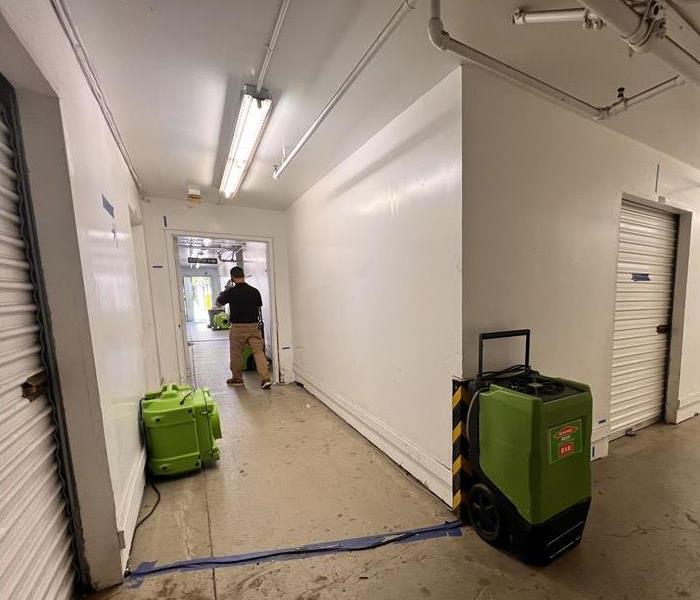 Addressing mold issues promptly and effectively is crucial to maintaining a safe and healthy living environment.
Addressing mold issues promptly and effectively is crucial to maintaining a safe and healthy living environment.
Discovering mold in your insulation can be alarming. Mold not only damages your property but also affects the air quality in your home. Addressing mold issues promptly and effectively is crucial to maintaining a safe and healthy living environment. In this blog, we'll guide you through the steps to take if you find mold in your insulation, including how to identify mold, remove it, and prevent future growth.
How to Identify Mold in Insulation
Mold can be tricky to spot, especially when it’s hidden in insulation. Here are some common signs that you might have mold in your insulation:
- Musty Odor
One of the first indicators of mold is a musty, unpleasant odor. If you notice a persistent smell in certain areas of your home, it could be a sign of mold in the insulation.
- Visible Mold Growth
Check your insulation for any visible signs of mold. Mold can appear as black, green, or white spots and can often be found in damp or poorly ventilated areas.
- Discoloration or Stains
Discoloration or stains on walls and ceilings near the insulation can indicate mold growth. If you notice unusual stains, it's worth investigating further to determine if mold is present.
Steps to Take If You Find Mold in Insulation
If you suspect or find mold in your insulation, it's important to take immediate action. Here are the steps to follow:
- Assess the Extent of the Mold
Determine how widespread the mold problem is. A small, localized area can often be handled by homeowners, but larger infestations may require professional assistance.
- Wear Protective Gear
When dealing with mold, always wear protective gear, including gloves, a mask, and goggles. This helps prevent exposure to mold spores.
- Isolate the Area
Seal off the affected area to prevent mold spores from spreading to other parts of your home. Use plastic sheeting and tape to cover doorways and vents.
- Remove Contaminated Insulation
Carefully remove the moldy insulation and place it in heavy-duty plastic bags. Seal the bags tightly and dispose of them according to local regulations. Be sure to handle the insulation gently to avoid releasing mold spores into the air.
- Clean the Surrounding Area
After removing the contaminated insulation, clean the surrounding area thoroughly. Use a mold removal solution or a mixture of water and detergent to scrub all surfaces. Be sure to dry the area completely to prevent mold from returning.
- Replace the Insulation
Once the area is clean and dry, replace the old insulation with new, mold-resistant insulation. This can help prevent future mold growth and improve your home's overall insulation.
- Fix the Moisture Problem
Mold thrives in moist environments, so it's essential to address any underlying moisture issues. Check for leaks, improve ventilation, and consider using a dehumidifier to keep humidity levels in check.
Finding mold in your insulation can be a daunting experience, but with the right steps, you can effectively address and prevent it. By identifying the signs of mold, safely removing contaminated insulation, and taking preventive measures, you can maintain a healthy and safe living environment. If you encounter a significant mold problem, don’t hesitate to contact a professional mold remediation service like SERVPRO of Mid-City San Diego for expert assistance. Keeping your home mold-free ensures better air quality and protects your property from damage.
The Role of Insurance in Water Damage Restoration
6/12/2024 (Permalink)
 Your insurance coverage plays a major role in water damage restoration, and our team can help you out with it!
Your insurance coverage plays a major role in water damage restoration, and our team can help you out with it!
Water damage can occur unexpectedly, posing a threat to your property and belongings. In such situations, having the right insurance coverage can make a significant difference in the restoration process. Understanding the role of insurance in water damage restoration is crucial for homeowners and business owners alike. In this blog, we will explore the importance of insurance in water damage restoration and how it can help mitigate the financial impact of such incidents.
Types of Insurance Coverage
Different types of insurance policies provide coverage for water damage. The primary ones include:
- Homeowners Insurance: Most standard homeowners insurance policies cover water damage caused by sudden and accidental incidents, such as burst pipes or appliance malfunctions.
- Flood Insurance: Flood damage is typically not covered by standard homeowners insurance. Residents in flood-prone areas are encouraged to obtain separate flood insurance policies to protect their properties from damage caused by rising waters.
- Commercial Property Insurance: Business owners can protect their properties from water damage through commercial property insurance, which typically covers water damage caused by burst pipes, roof leaks, or other covered perils.
Assessing Coverage
Understanding the specifics of your insurance coverage is essential. When faced with water damage, it is crucial to assess your policy to determine the extent of coverage for the damage. It is advisable to be aware of any limitations or exclusions that may affect your coverage for water damage incidents.
Filing an Insurance Claim
In the event of water damage, filing an insurance claim promptly is vital. When filing a claim, it is important to provide detailed documentation of the damage, including photographs and a thorough inventory of the affected items. Additionally, engaging the services of a professional water damage restoration company can help facilitate the claims process, as they can provide comprehensive documentation and estimates for the restoration work.
Working with Restoration Professionals
Reputable water damage restoration companies often have experience working with insurance companies. They can assist in the claims process by providing accurate assessments, cost estimates, and supporting documentation. Working with professionals can help streamline the restoration process and ensure that the necessary repairs and remediation work are conducted promptly and effectively.
Maximizing Insurance Benefits
Making informed decisions when it comes to insurance claims can help maximize your benefits. It is advisable to keep records of all communication with the insurance company, including claim forms, estimates, and receipts for any expenses related to the restoration process. Maintaining thorough documentation can help ensure that you receive fair compensation for the restoration of your property.
In conclusion, insurance plays a crucial role in water damage restoration by providing financial protection and assistance in the event of unforeseen incidents. Understanding your insurance coverage, filing claims promptly, and working with professional restoration experts can help mitigate the impact of water damage and expedite the restoration process. If you require assistance with water damage restoration, contact SERVPRO® for reliable and professional restoration services.
Common Types of Storm Damage and How to Prevent Them
5/15/2024 (Permalink)
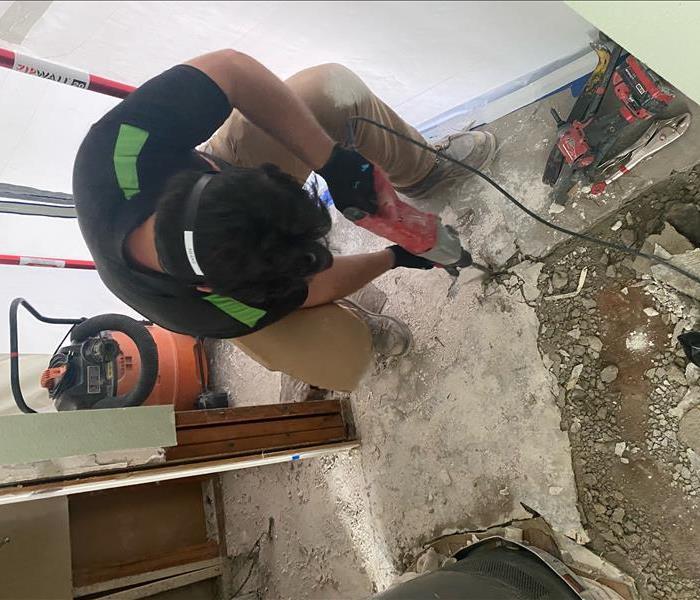 In this blog, we will explore the most common types of storm damage in San Diego and provide valuable tips on how to prevent them.
In this blog, we will explore the most common types of storm damage in San Diego and provide valuable tips on how to prevent them.
Living in San Diego, the beautiful Southern California city known for its mild climate and pleasant weather can sometimes be disrupted by severe storms. These storms can bring strong winds, heavy rains, and even hail, resulting in significant damage to homes and properties. In this blog, we will explore the most common types of storm damage in San Diego and provide valuable tips on how to prevent them, ensuring the safety and well-being of your property.
Structural Wind Damage
Strong winds during storms can cause structural damage to homes, compromising their integrity. To prevent severe structural wind damage, consider the following measures:
- Reinforce Roofing: Ensure that your roof is secure by checking for loose or damaged shingles, as well as providing proper insulation and reinforcement.
- Secure Doors and Windows: Install storm shutters or impact-resistant windows and doors to protect against wind pressure and flying debris.
- Trim Trees and Branches: Regularly trim trees near your property to prevent falling branches or trees during storms. Consult with an arborist or tree service professional for proper tree maintenance.
Flooding and Water Damage
Heavy rains associated with storms can lead to flooding and water damage inside your home. Take these preventative steps to minimize the risk:
- Maintain Gutters and Downspouts: Clean your gutters regularly to ensure proper water flow and direct water away from the foundation. Install downspout extensions to divert water further from the house.
- Improve Drainage: Ensure that the grading around your property slopes away from the foundation to prevent water from pooling near the building.
- Waterproof Basements and Crawl Spaces: Apply waterproof coatings or sealants to basement walls and floors. Install a sump pump in basements or crawl spaces prone to flooding.
Hail Damage
Although not as common in San Diego, hailstorms can cause significant damage to your home. Take the following preventive measures:
- Inspect and Maintain Roofing: Regularly inspect your roof for loose, damaged, or missing shingles. Consider impact-resistant roofing materials or hail guards for added protection.
- Protect Vehicles: If possible, park vehicles in garages or under-covered areas during hailstorm warnings. If no covered options are available, use car covers or find temporary shelter during the storm.
Power Outages
Storms can cause power outages, leaving your home vulnerable and uncomfortable. Consider these steps to mitigate the impact of power loss:
- Install Backup Power Systems: Invest in a backup power generator to ensure your home has a reliable source of electricity during outages. Consult with a professional to determine the appropriate generator for your needs.
- Prepare Emergency Kits: Assemble emergency kits that include flashlights, batteries, non-perishable food, and drinking water. These kits will help ensure your comfort and safety during power outages.
- Surge Protection: Install surge protectors to safeguard sensitive electronics and appliances against power surges caused by storms.
Implementing these preventative measures can minimize the risk of severe home damage from storms in San Diego. However, in the event of storm damage, it is crucial to contact professionals like SERVPRO® to assess and restore any structural wind damage, water damage, or hail damage promptly.
In Conclusion
San Diego's mild climate does not exempt it from the occasional severe storm. Understanding the most common types of storm damage and taking preventative measures can help protect your property and keep occupants safe. From reinforcing the structure against strong winds to mitigating flooding risk and preparing for power outages, taking proactive steps is the key to preventing severe home damage. Remember, in the event of storm damage, SERVPRO is always ready to assist with professional assessment and restoration to restore your property efficiently and effectively.
The Different Stages of Fire Damage Restoration
4/17/2024 (Permalink)
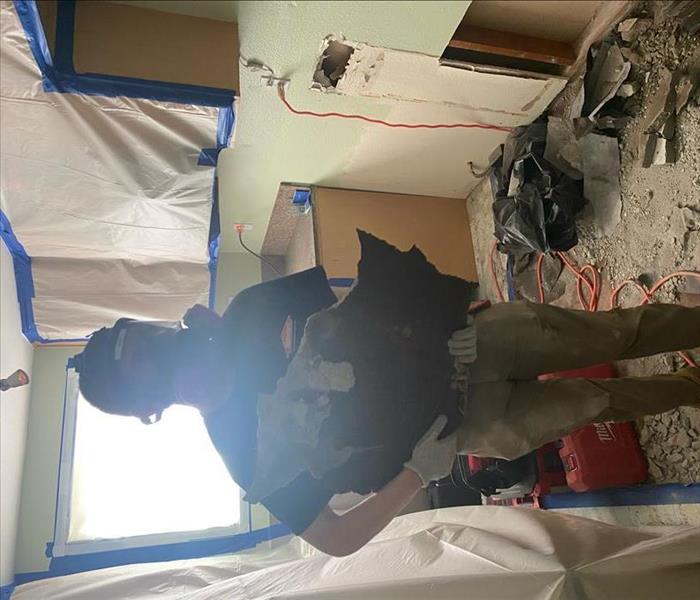 In this blog, we will explore the key stages involved in fire damage remediation and restoration.
In this blog, we will explore the key stages involved in fire damage remediation and restoration.
When a fire strikes, the aftermath can be overwhelming. Fire damage not only affects the structure of a building but also personal belongings. Fortunately, professional fire damage restoration services, like those offered by SERVPRO®, can help restore your property to its pre-fire condition. Understanding the different stages of fire damage restoration is essential to ensure a successful and comprehensive restoration process. In this blog, we will explore the key stages involved in fire damage remediation and restoration. By familiarizing yourself with these stages, you can better prepare for the restoration process and get your life back on track.
Emergency Response and Inspection
The first stage of fire damage restoration is the emergency response and inspection. As soon as it is safe to do so, contact a professional fire restoration company, such as SERVPRO, for immediate assistance. They will dispatch a team of certified technicians to assess the extent of the fire damage and create an action plan tailored to your specific needs.
During the inspection, professionals will assess structural damage, examine affected areas, and identify the extent of smoke damage to personal belongings. This crucial step allows them to develop an efficient and effective restoration plan.
Water Removal and Drying
Water damage often accompanies fire damage due to firefighting efforts. The next stage involves water removal and drying to prevent secondary damage, such as mold growth. Certified technicians will utilize specialized equipment to extract standing water, dehumidify the area, and initiate the drying process.
Prompt action is crucial during this stage, as it helps minimize further damage and prepares the space for the next steps in the restoration process.
Smoke and Soot Cleanup
Fire damage leaves behind smoke and soot that can permeate every surface of a building, including personal belongings. Smoke and soot cleanup is an integral part of fire damage restoration. Professionals will employ advanced techniques and equipment to remove smoke residues, clean affected surfaces, and eliminate lingering odors.
This stage involves specialized cleaning methods suitable for specific materials and items. Professionals will meticulously clean and restore personal belongings, including furniture, clothing, upholstery, and electronics.
Structural Repair and Reconstruction
Once the cleanup is complete, the focus shifts to structural repair and reconstruction. This stage involves repairing damaged walls, ceilings, floors, and other structural components. SERVPRO professionals are experienced in handling the restoration of fire-damaged structures, ensuring that repairs are made to safeguard the structural integrity of the building.
Content Restoration and Cleaning
During a fire, personal belongings can suffer smoke damage and require cleaning and restoration. SERVPRO offers comprehensive content restoration services, including document and electronics restoration, art and antique restoration, and delicate item cleaning. This stage ensures that your valuable belongings are restored whenever possible.
Final Inspection and Completion
The final stage of fire damage restoration involves a thorough inspection to ensure everything has been restored to its pre-fire condition. Professionals will review the restoration work, addressing any remaining concerns or touch-ups. Once the final inspection is complete, you can confidently move back into your home or resume business operations.
Fire damage restoration is a complex and multifaceted process that requires professional expertise. Understanding the different stages – emergency response, water removal and drying, smoke and soot cleanup, structural repair, content restoration, and final inspection – helps homeowners and businesses prepare for the restoration journey. Through the expertise of certified technicians at SERVPRO, fire-damaged structures can be restored, personal belongings can be cleaned and restored, and life can gradually return to normal. Trusting the restoration process to professionals ensures a comprehensive and successful fire damage restoration experience.
Mold in Your Basement: Causes and Remediation Strategies
3/13/2024 (Permalink)
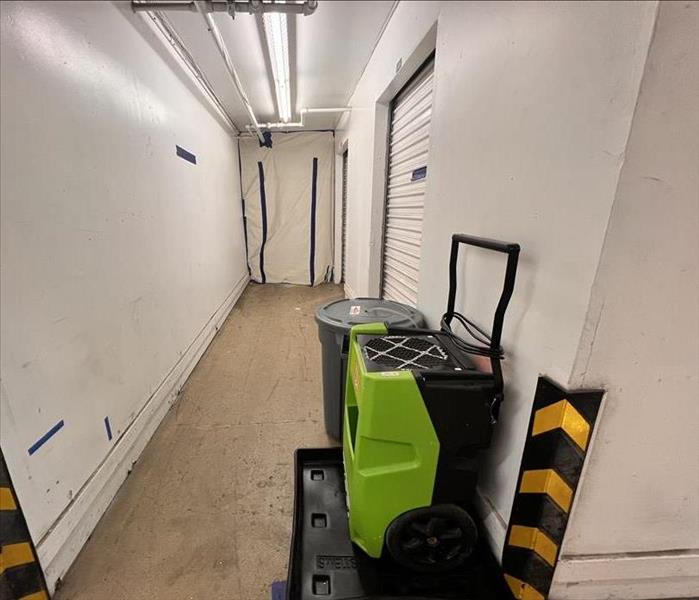 In this blog, we will explore why mold may occur in basements and provide tips on how to remediate mold effectively.
In this blog, we will explore why mold may occur in basements and provide tips on how to remediate mold effectively.
Discovering mold in your basement can be a concerning issue. While mold growth poses potential risks to your property, it is important to understand the causes and effective remediation strategies for addressing mold in your basement. In this blog, we will explore why mold may occur in basements and provide tips on how to remediate mold effectively.
Causes of Mold in Basements
Basements are prone to mold growth due to several contributing factors. Understanding these causes can help in preventing mold in the first place. Here are some common causes of mold in basements:
- Moisture Intrusion: Excessive moisture in the form of water leaks or seepage is one of the primary culprits behind mold growth in basements. Leaky pipes, foundation cracks, or floods can introduce moisture into the basement, creating an ideal environment for mold to thrive.
- Poor Ventilation: Inadequate air circulation and ventilation in basements trap moisture, increasing the humidity levels. Higher humidity provides the necessary conditions for mold growth.
- Dampness and Condensation: Basements tend to be cooler than the rest of the house, making them more prone to condensation. When warm air comes into contact with cooler surfaces, such as walls or pipes, condensation can occur, creating a moist environment suitable for mold growth.
Remediation Strategies
If you discover mold in your basement, prompt action is crucial to prevent further damage. Here are some effective remediation strategies to tackle the issue:
- Identify and Fix the Source of Moisture: Start by locating and addressing any sources of moisture intrusion in your basement. Repair pipe leaks, seal foundation cracks, and address any other issues causing moisture to enter your basement. This step is vital to prevent recurring mold growth.
- Improve Ventilation: Enhance the airflow in your basement by using fans or opening windows. Consider installing an exhaust fan or a dehumidifier specifically designed for basements to help reduce humidity levels.
- Remove Mold-Infested Materials: If there are porous materials like carpets, drywall, or insulation that have been extensively affected by mold, it may be necessary to remove and replace them to eliminate mold completely.
- Clean and Disinfect: For mold growth on solid surfaces, use a solution of one part white vinegar to three parts water or a commercial mold cleaner recommended for use in basements. Scrub the affected areas thoroughly, ensuring all visible mold growth is removed.
- Dry Thoroughly: After cleaning, make sure to dry the basement entirely to prevent future mold growth. Use fans, dehumidifiers, and open windows to promote airflow and remove any lingering moisture.
- Consult Professionals: If the mold growth is extensive or if you are unsure about the proper remediation process, consult professionals like SERVPRO® who specialize in mold restoration services. They have the expertise, equipment, and techniques to handle severe cases of mold in basements, ensuring effective remediation.
Understanding the causes and implementing appropriate remediation strategies are vital steps in addressing mold in your basement. By identifying and rectifying the sources of moisture intrusion, improving ventilation, and taking prompt action to remove mold growth, you can restore your basement and prevent further damage. Remember, prevention is key, so regularly inspect your basement for any signs of moisture or mold and address issues promptly to maintain a healthy and mold-free environment.
Under the Weather: Tackling Roof Leaks and Water Damage
2/11/2024 (Permalink)
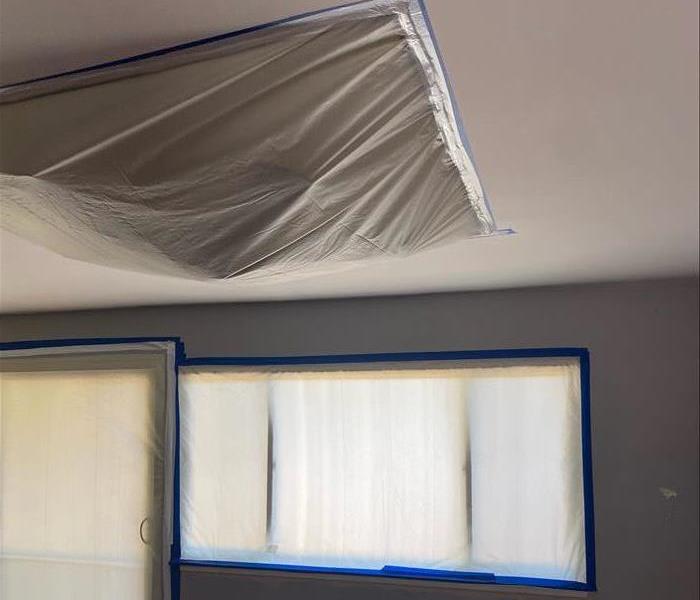 A leaky roof is more than a minor inconvenience; it's a gateway for potential water damage.
A leaky roof is more than a minor inconvenience; it's a gateway for potential water damage.
A leaky roof is more than a minor inconvenience; it's a gateway for potential water damage. Detecting and addressing roof leaks promptly is crucial for preventing extensive damage and costly repairs. In this blog, we explore the importance of regular roof inspections, the common causes of roof leaks, and effective repair strategies to keep your home dry and secure.
The Significance of Roof Inspections
Regular roof inspections are the first line of defense against water damage. They allow homeowners to identify potential issues early, preventing minor leaks from escalating into major problems. Schedule inspections at least twice a year, ideally in the spring and fall, and after severe weather events.
Common Causes of Roof Leaks
Understanding the common culprits behind roof leaks empowers homeowners to address issues promptly. Some prevalent causes include:
- Damaged or Missing Shingles
- Aging Roofing Materials
- Flashing Issues
- Clogged Gutters
Early Detection
Identifying roof leaks in their early stages is crucial. Look for signs such as water stains on ceilings, discolored walls, or peeling paint. During inspections, pay attention to the condition of the roof, checking for loose or damaged shingles, deteriorated flashing, and any other visible issues.
DIY Repairs vs. Professional Assistance
While some homeowners may attempt DIY roof repairs, it's crucial to assess the complexity of the issue. Simple tasks like replacing a few missing shingles may be manageable, but more intricate problems, such as flashing issues or widespread damage, often require professional expertise. Roofing professionals can conduct thorough assessments and provide long-lasting solutions.
Flashing Repairs
Damaged flashing can compromise the integrity of your roof. Professional roofers can assess the condition of flashing and make necessary repairs or replacements to ensure a watertight seal around vulnerable areas. Clogged gutters and downspouts are also a common cause of roof leaks. Regularly clean out debris, ensuring unobstructed water flow.
In cases of sudden roof damage, such as severe storms or fallen branches, it's crucial to address emergency repairs quickly. Tarping or covering damaged areas can provide temporary protection until more extensive repairs can be conducted.
With regular inspections and timely repairs, homeowners can protect their homes against these threats. By staying vigilant, promptly addressing issues, and seeking professional assistance when needed, you ensure that your roof remains a strong protector, keeping your home dry and secure for years to come.
Understanding the Impact of Wind Damage & the Steps to Restoration
1/14/2024 (Permalink)
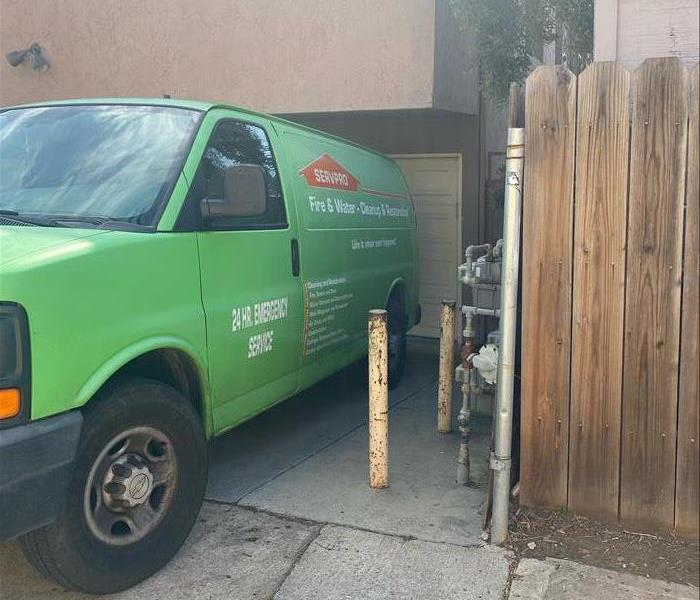 Whether it's from a severe storm, tornado, or hurricane, the aftermath of wind damage can be distressing and overwhelming.
Whether it's from a severe storm, tornado, or hurricane, the aftermath of wind damage can be distressing and overwhelming.
Wind damage can wreak havoc on homes and businesses. Whether it's from a severe storm, tornado, or hurricane, the aftermath of wind damage can be distressing and overwhelming. Understanding the implications of wind damage and knowing how to navigate the restoration process is crucial for swift recovery.
The Impact of Wind Damage
1. Roof Damage
Strong winds can uplift or dislodge shingles, cause roof leaks, or even lead to structural compromises. Timely inspection and repair are essential to prevent further water intrusion or structural issues.
2. Structural Compromise
Wind can weaken the structural integrity of buildings, causing damage to walls, windows, and doors. This may compromise the safety and security of the property.
3. Debris and Impact
Flying debris during high winds can cause severe damage to property exteriors, including siding, fences, and landscaping. Impact damage may necessitate repairs or replacements.
Steps to Address Wind Damage
1. Safety First
Prioritize safety. Assess the property for any immediate dangers and avoid entering areas that could pose risks due to structural instability.
2. Documentation
Document the damage by taking photographs or videos. This documentation will assist in insurance claims and help professionals understand the extent of the damage.
3. Temporary Repairs
Take immediate action to prevent further damage. Cover broken windows, tarp tarp-damaged roofs, and secure any exposed areas to mitigate additional harm.
4. Professional Assessment
Contact certified restoration professionals like SERVPRO of Mid-City San Diego to conduct a thorough assessment of the damage. Their expertise is vital in understanding the full scope of the restoration needed.
The Restoration Process
1. Inspection and Assessment
Trained technicians will perform a detailed inspection to identify all areas of damage and develop a comprehensive restoration plan.
2. Water Extraction and Drying
If water intrusion has occurred due to wind damage, professionals will extract standing water and implement drying techniques to prevent further issues like mold growth.
3. Structural Repairs
Repairing damaged structures, roofs, walls, windows, and doors is a priority. This ensures the property's safety and prevents further deterioration.
4. Cleanup and Restoration
Professionals will thoroughly clean debris, restore damaged areas, and return the property to its pre-damage condition.
Importance of Professional Assistance
Seeking professional help for wind damage restoration is crucial. Trained experts possess the skills, equipment, and experience necessary to efficiently restore your property. Their swift response can mitigate further damage and expedite the recovery process.
Wind damage can be a distressing ordeal, but with the right approach and professional assistance, recovery is possible. Prompt action, thorough assessment, and skilled restoration are crucial in mitigating wind damage's aftermath.
At SERVPRO of Mid-City San Diego, our dedicated team is committed to providing efficient wind damage restoration services, helping you restore safety, security, and peace of mind to your property. Contact us for expert assistance in navigating the restoration process and recovering swiftly from wind damage.
Cooking Safely: How to Prevent Kitchen Fires and What to Do If One Occurs
12/20/2023 (Permalink)
 Despite your best efforts, kitchen fires can still happen.
Despite your best efforts, kitchen fires can still happen.
The kitchen is the heart of your home, where delicious meals are prepared, and cherished memories are made. However, it's also a place where fires can happen if safety precautions are overlooked. In this blog, we'll provide valuable tips on preventing kitchen fires and outline the steps to take in case one occurs. By following these guidelines, you can protect your family, property, and peace of mind.
Prevention is Key
Preventing kitchen fires starts with being proactive and vigilant. Here are some essential steps you can take to reduce the risk of fires in your kitchen:
Never Leave Cooking Unattended
The most common cause of kitchen fires is unattended cooking. Stay in the kitchen when you're frying, grilling, or broiling, and use a timer to remind you of the cooking process.
Keep Flammable Items Away
Keep dish towels, oven mitts, and paper towels away from the stovetop. Loose clothing should be tucked in to prevent accidental contact with burners.
Regularly Clean Your Appliances
Grease and food particles can accumulate on stovetops and in ovens, creating a fire hazard. Clean your appliances regularly to avoid this.
Check for Faulty Wiring
Faulty wiring in kitchen appliances can lead to electrical fires. Regularly inspect your appliances for damaged cords or outlets.
Install a Smoke Alarm
Ensure your kitchen is equipped with a working smoke alarm. Test it regularly, and replace the batteries as needed.
What to Do in Case of a Kitchen Fire
Despite your best efforts, kitchen fires can still happen. Knowing how to react quickly and effectively can make all the difference. Here's a step-by-step guide on what to do if a kitchen fire occurs:
- Stay Calm
The most critical step is to remain calm. Panic can hinder your ability to respond effectively.
- Turn Off the Heat
If a fire starts in a pot or pan, turn off the heat source immediately.
- Use a Lid or Fire Extinguisher
If the fire is small and contained, you can try to smother it by covering the pot or pan with a lid. Alternatively, use a fire extinguisher designed for kitchen fires. Always have a fire extinguisher nearby and know how to use it.
- Never Use Water
Never use water to extinguish a grease fire, as it can cause the flames to spread. It's crucial to remember this.
- Evacuate Safely
If the fire is not quickly extinguished or grows out of control, evacuate the kitchen and close the door behind you. Call 911 immediately.
- Stay Low
If the kitchen is filled with smoke, stay low to the ground, where the air is less smoky.
Preventing kitchen fires and knowing how to respond if one occurs is essential for the safety of your family and your home. By following these guidelines and staying vigilant in the kitchen, you can greatly reduce the risk of fires. Remember to have a working smoke alarm, fire extinguisher, and a well-thought-out evacuation plan. Cooking can be enjoyable and safe when you take the right precautions. Your kitchen should always be a place of warmth and comfort, not a source of danger!
A Complete Guide to the Mold Damage Restoration Process
11/16/2023 (Permalink)
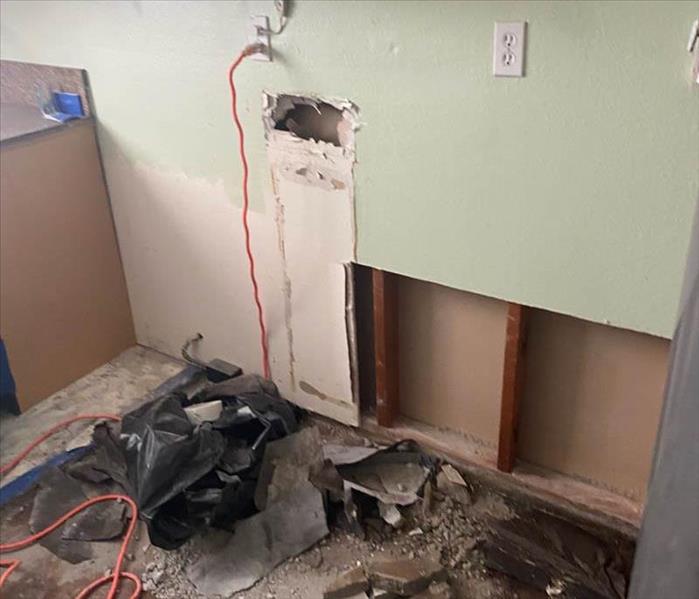 Mold damage can be a homeowner's worst nightmare
Mold damage can be a homeowner's worst nightmare
Mold damage can be a homeowner's worst nightmare. Understanding the mold damage restoration process is essential to effectively address this issue and restore your home to a safe and comfortable living space. In this blog, we provide a comprehensive guide to the steps involved in the mold damage restoration process.
1. Initial Assessment
The first step in the mold damage restoration process is a thorough assessment of the affected area. This involves identifying the type of mold, the extent of the infestation, and the underlying causes, such as leaks or high humidity. A precise assessment is essential for developing a targeted restoration plan.
2. Isolation and Containment
To prevent the spread of mold spores, containment measures are implemented. Plastic sheeting and negative air pressure systems are used to isolate the affected area and prevent cross-contamination.
3. Mold Removal
The next critical step is the safe and thorough removal of mold from affected surfaces. Moldy materials may need to be discarded, and specialized cleaning techniques are employed to eliminate mold and its spores.
4. Air Filtration
High-efficiency particulate air (HEPA) filtration systems are used to capture airborne mold spores and particles, further preventing the spread of mold during the removal process.
5. Cleaning and Sanitizing
All surfaces and materials in the affected area are meticulously cleaned and sanitized to eliminate any remaining traces of mold and prevent its return.
6. Drying and Dehumidification
Addressing the underlying moisture issue is crucial to prevent future mold growth. Dehumidifiers and air movers are used to ensure the affected area is thoroughly dried.
7. Repairs and Restoration
If structural materials or surfaces were damaged during the mold infestation, repairs and restoration are carried out to return your home to its pre-damage condition.
8. Final Inspection
A final inspection is conducted to verify that all mold has been removed, and the property is safe for occupancy. Any necessary adjustments or additional repairs are made at this stage.
9. Preventative Measures
To ensure mold doesn't return, it's essential to address the root causes of the infestation, such as fixing leaks, improving ventilation, and reducing humidity levels.
10. Documentation
Throughout the restoration process, detailed documentation is maintained, including photographs, moisture readings, and records of all work performed. This documentation is crucial for insurance claims and future peace of mind.
Understanding the mold damage restoration process is the first step to a successful recovery. When dealing with mold, it's essential to work with a professional restoration team like SERVPRO® of Mid-City San Diego. We have the experience, expertise, and resources to efficiently restore your property and ensure it remains mold-free. If you're facing mold damage, don't hesitate to reach out for immediate assistance!
How To Improve Your Indoor Air Quality After Water Damage
10/10/2023 (Permalink)
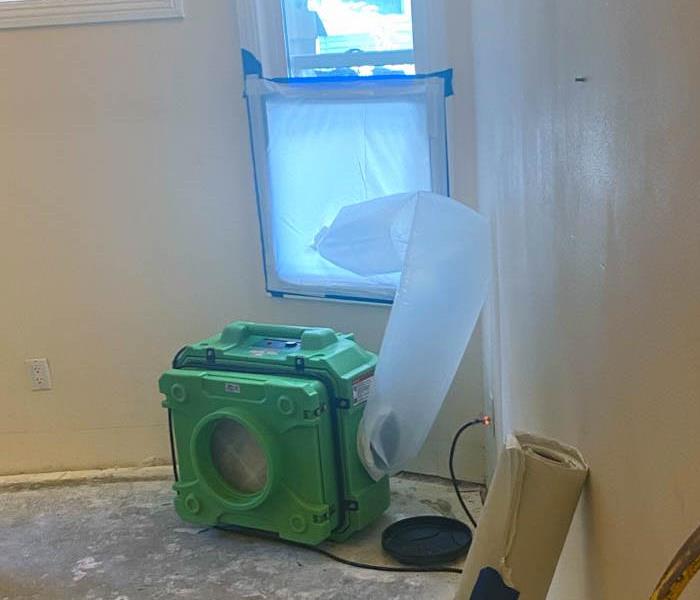 Restoring indoor air quality after water damage is crucial for your well-being.
Restoring indoor air quality after water damage is crucial for your well-being.
Water damage can be a distressing experience for homeowners in San Diego, but it's not just the visible damage that's a concern. Water intrusion can also compromise your indoor air quality. In this blog, we'll explore the steps you can take to restore indoor air quality after water damage in your San Diego home.
Understanding the Impact on Indoor Air Quality
Water damage can introduce a variety of pollutants into your home's indoor air, including:
Mold Spores: Moisture creates the ideal conditions for mold growth, and mold spores can easily become airborne and spread.
Bacteria and Pathogens: Contaminated water can carry harmful bacteria and pathogens, posing risks.
Dust Mites: Increased humidity levels can promote dust mite populations.
Steps to Restore Indoor Air Quality After Water Damage
Ensure Safety
Before tackling air quality restoration, ensure your safety by turning off electrical power if necessary and wearing appropriate protective gear.
Remove Standing Water
The first step is to remove standing water and moisture. Use pumps, fans, and dehumidifiers to expedite the drying process.
Address Mold and Mildew
Mold and mildew can thrive in damp conditions. Inspect your home for visible signs of mold and mildew and address them promptly through professional remediation.
Ventilation
Increase ventilation by opening windows and doors, and using fans to circulate air. Good airflow helps remove pollutants from your indoor environment.
Dehumidification
Maintain indoor humidity levels below 50% to discourage mold, bacteria, and dust mites. Use dehumidifiers if necessary.
Clean and Disinfect
Clean and disinfect surfaces thoroughly to remove contaminants. Use appropriate cleaning agents to ensure effective disinfection.
Air Purification
Consider using air purifiers with HEPA filters to trap airborne particles, including mold spores and bacteria. Ensure your HVAC system has a clean filter.
Professional Assistance
In severe cases of water damage, it's wise to seek professional assistance. SERVPRO® of Mid-City San Diego specializes in water damage restoration and indoor air quality improvement.
Restoring indoor air quality after water damage is crucial for your well-being. While you can take several steps on your own, for the most effective and thorough restoration, consider enlisting the expertise of professionals like SERVPRO® of Mid-City San Diego. Our team has the knowledge, experience, and equipment to address water damage and its impact on indoor air quality, ensuring your home is safe and comfortable once again. Remember, prioritizing indoor air quality is a significant step in the recovery process after water damage.
 Addressing mold issues promptly and effectively is crucial to maintaining a safe and healthy living environment.
Addressing mold issues promptly and effectively is crucial to maintaining a safe and healthy living environment.




 24/7 Emergency Service
24/7 Emergency Service








